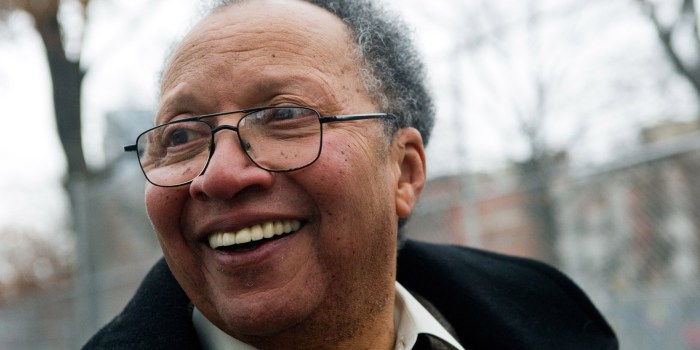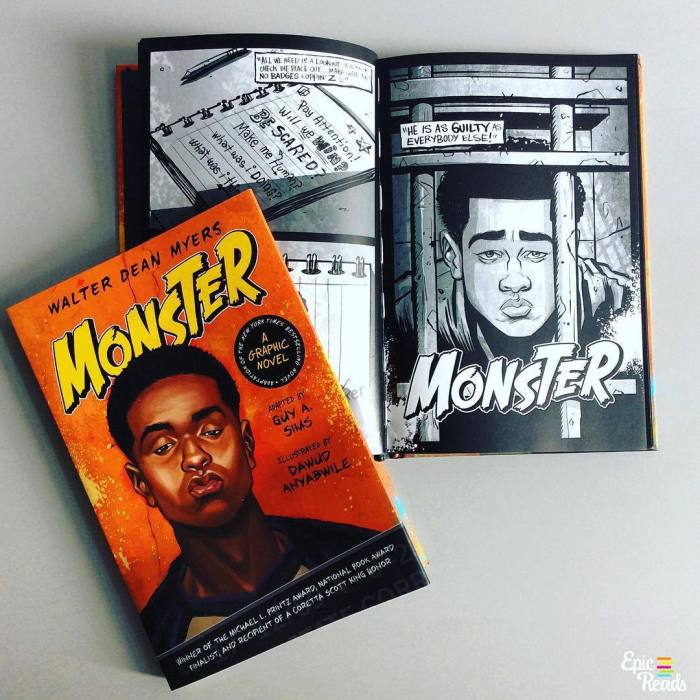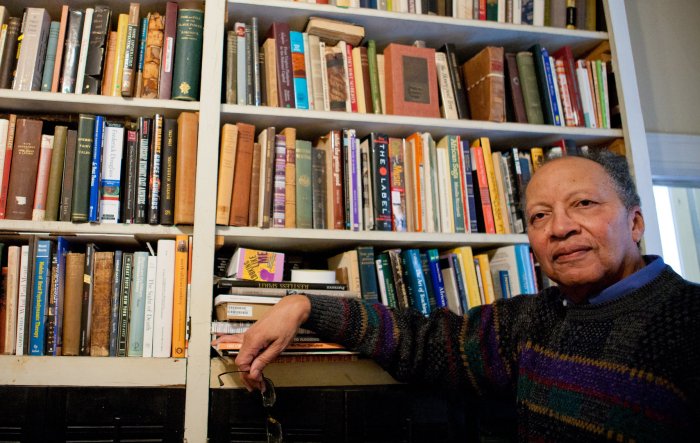Kick by Walter Dean Myers introduces a gripping narrative, inviting readers into a world of intricate characters, thought-provoking themes, and captivating symbolism. The novel delves into the complexities of identity, family, and community, leaving an enduring impact on its audience.
As the story unfolds, we witness the transformative journey of the protagonist, exploring their motivations, relationships, and the profound impact of their experiences. Myers’ masterful writing style weaves a tapestry of emotions, immersing us in the struggles and triumphs of the characters.
Character Analysis

Kick, the protagonist of Walter Dean Myers’ novel, is a complex and multifaceted character. He is a young black teenager living in Harlem in the 1970s, and his experiences are shaped by the social and economic challenges of his environment.
Kick is a talented athlete, but his dreams of a better life are threatened by the dangers and temptations that surround him.
Motivations and Personality Traits
Kick is driven by a strong desire to escape the poverty and violence of his neighborhood. He is determined to succeed in life, and he sees basketball as his ticket out. Kick is also a loyal and compassionate friend, and he is always willing to help those in need.
Relationships with Other Characters, Kick by walter dean myers
Kick’s relationships with other characters are complex and often strained. He has a close relationship with his mother, but he often clashes with his stepfather. Kick also has a complicated relationship with his friends, who often lead him into trouble.
However, Kick ultimately learns to rely on his friends for support and guidance.
Symbolism
Kick’s name is symbolic of his character. The word “kick” can mean to strike or to protest, and it also refers to the act of playing soccer. Kick is a fighter, and he is determined to overcome the obstacles in his path.
He is also a talented soccer player, and he uses his skills to express himself and to connect with others.
Plot Summary

Walter Dean Myers’ Kickunfolds in the racially charged streets of Harlem, New York, during the 1970s. The novel follows the journey of Lewis Reed, a troubled young man navigating the complexities of life in an underprivileged neighborhood.
Main Events
Lewis, nicknamed “Kick,” grapples with poverty, violence, and a broken family. His father is an alcoholic, and his mother is overwhelmed by the challenges of raising a son in a harsh environment. Kick seeks solace in basketball, where he finds a sense of purpose and belonging.
However, his life takes a tragic turn when his best friend is killed in a gang-related shooting.
Climax and Falling Action
The climax of the novel occurs when Kick witnesses his friend’s murder. This event shatters his illusions about the safety of his community and the possibility of a better future. The falling action follows Kick as he struggles to cope with the loss and confront the realities of his life.
Pacing and Structure
Kickis a fast-paced novel that unfolds in a series of short, intense chapters. Myers’ writing style is characterized by its realism and immediacy, capturing the raw emotions and struggles of his characters. The novel is structured around Kick’s personal journey, with each chapter representing a step in his development.
Walter Dean Myers’ “Kick” is a powerful novel that explores the complexities of urban life. If you’re looking for a fun and educational way to learn about waves, check out the Bill Nye Wave Video Quiz . Then, come back to “Kick” and delve into the struggles and triumphs of its unforgettable characters.
Themes

Walter Dean Myers’ Kickexplores a multitude of themes, including identity, family, and community. These themes are interwoven throughout the novel, shaping the characters’ experiences and the overall narrative.
Identity
The search for identity is a central theme in Kick. The protagonist, Robbie, struggles with his sense of self as he navigates the challenges of adolescence and his family’s expectations. Through Robbie’s journey, Myers explores the complexities of identity formation, including the influence of culture, family, and personal experiences.
- Robbie’s struggle to reconcile his African American heritage with his aspirations to become a soccer player highlights the challenges of navigating multiple identities.
- Coach Carter’s mentorship helps Robbie embrace his own unique identity and find his place in the world.
Family
Family is another important theme in Kick. Robbie’s family provides both support and conflict as he grows and develops. Myers portrays the complex dynamics of family relationships, including the challenges of communication, generational differences, and the importance of love and forgiveness.
- Robbie’s strained relationship with his father reflects the challenges of understanding and connecting with different generations.
- The support and love of Robbie’s mother and sister provide a constant source of strength and resilience.
Community
The novel also explores the theme of community. Robbie’s soccer team becomes a surrogate family for him, providing a sense of belonging and purpose. Myers emphasizes the importance of community support and the power of collective action.
- The team’s collective goal of winning the championship unites the players and creates a sense of shared purpose.
- The community rallies around Robbie and his team, demonstrating the power of support and solidarity.
Symbolism: Kick By Walter Dean Myers
Walter Dean Myers’s Kickis rich in symbolism, employing objects, colors, and images to convey deeper meanings and enhance the novel’s themes.
Objects
- The football:Represents both the protagonist’s passion and his struggles. Its possession brings him joy and a sense of purpose, but its loss symbolizes his failures and disappointments.
- The field:Symbolizes the battleground of life, where characters face challenges and strive for success.
- The locker room:A place of both refuge and confrontation, where characters confront their emotions and seek support.
Colors
- Green:Associated with the football field and represents hope, growth, and potential.
- Black:Represents the protagonist’s race and the challenges he faces due to prejudice.
- White:Symbolizes the opposing team and the obstacles the protagonist must overcome.
Images
- The “kick”:Represents the protagonist’s determination to succeed and his willingness to take risks.
- The “pass”:Symbolizes the protagonist’s ability to connect with others and seek help when needed.
- The “fumble”:Represents the protagonist’s mistakes and the consequences of his actions.
Writing Style

Walter Dean Myers’ writing style in “Kick” is characterized by its raw, honest, and evocative language. He uses vivid imagery and a conversational tone to immerse readers in the protagonist’s experiences.
Language and Imagery
Myers’ use of language is precise and often poetic, capturing the emotions and experiences of his characters with depth and nuance. He employs similes, metaphors, and sensory details to create a rich and immersive reading experience.
“The ball was like a comet, streaking through the air, leaving a trail of dust in its wake.”
Conversational Tone
The novel is written in a conversational tone, as if the narrator is directly addressing the reader. This intimate approach draws readers into the story, creating a sense of immediacy and connection.
“I remember the first time I saw a homeless person. I was about ten years old, and I was walking home from school when I saw a man sitting on the sidewalk, his head in his hands.”
Overall Impact
Myers’ writing style contributes to the novel’s overall impact by creating a deeply personal and immersive experience for readers. The vivid language and conversational tone allow readers to connect with the characters on an emotional level, fostering empathy and understanding.
Historical Context

Kickwas written in 1997, during a period of heightened awareness of the systemic inequalities and social unrest faced by African Americans in the United States.
The novel’s themes of racism, poverty, and police brutality reflect the social and political issues that were prevalent in the late 20th century, particularly in urban areas.
Racial Tensions
The novel’s portrayal of the strained relationship between the black community and the police force mirrors the real-life tensions that existed during the 1990s. Incidents such as the Rodney King beating and the O.J. Simpson trial had brought issues of police brutality and racial profiling to the forefront of public consciousness.
Economic Inequality
Kickalso highlights the economic disparities between black and white communities. The novel’s setting in Harlem, a predominantly black neighborhood, reflects the widespread poverty and lack of opportunity that many African Americans faced in urban areas.
Political Climate
The political climate of the 1990s was marked by a conservative backlash against social welfare programs and affirmative action policies. This political shift contributed to the sense of disillusionment and anger that is expressed by many of the characters in Kick.
Questions and Answers
What is the central theme of Kick by Walter Dean Myers?
The novel explores the complexities of identity, family, and community, examining the challenges and triumphs faced by its characters.
How does Myers use symbolism in Kick?
Myers employs a range of symbols, such as the protagonist’s basketball and the neighborhood park, to convey deeper meanings and enhance the narrative.
What is the significance of the setting in Kick?
The novel’s setting in Harlem, New York, plays a crucial role in shaping the characters’ experiences and the themes of the story.